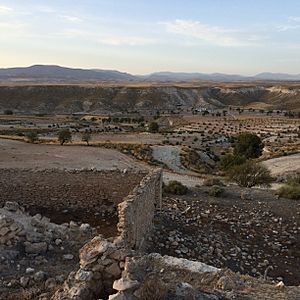Barranco León facts for kids
 |
|
| Location | Orce |
|---|---|
| Region | Province of Granada |
| Coordinates | 37°43′26.5620″N 02°27′02.8230″W / 37.724045000°N 2.450784167°W |
| Type | Archaeological site |
| History | |
| Periods | Pleistocene |
| Cultures | Oldowan |
| Site notes | |
| Excavation dates |
|
| Archaeologists |
|
Barranco León is a super old archaeological site in Spain. It's about 1.2 to 1.4 million years old! This means it's from a time called the Pleistocene epoch.
This site is famous because of a special discovery. Scientists found a tiny milk tooth here. It belonged to a child, maybe 10 years old. This tooth is called "Niño de Orce" (which means "Child of Orce"). It's one of the oldest signs of humans ever found in Western Europe. It shows that people lived in this area a very, very long time ago.
Contents
Exploring Barranco León
Scientists have carefully dug at Barranco León to learn more. The first excavations happened in 1995. A scientist named Josep Gibert i Clols led this work. More digging took place between 1999 and 2000. Martínez Fernández and Toro were in charge of those later explorations.
Tools from the Past
During the digs, archaeologists found many ancient tools. These tools are made of stone. They are called "lithic industry" or "stone tools". About 150 pieces were found. Most of them are small stone flakes and pieces of flint. These tools belong to a very early style called Oldowan (also known as Mode 1). This type of tool-making is very simple. It shows how early humans made basic tools to help them survive.
Ancient Animals of Barranco León
Besides tools and the child's tooth, scientists also found bones of huge ancient animals. These animals lived alongside early humans. Imagine seeing these creatures!
Here are some of the large mammals found at the site:
- Hippopotamus antiquus: This was a very old type of hippopotamus.
- Equus altidens: An ancient kind of horse.
- Felidae cf. Homotherium sp.: A type of big cat, possibly a saber-toothed cat.
- Megaloceros sp.: A giant deer with huge antlers.
- Bovini gen. et indet.: Bones from a large cattle-like animal.
These animal bones help us understand what the environment was like millions of years ago. They also show what kinds of animals early humans might have hunted or lived near.
Official Recognition
The Barranco León site is very important. The Geological and Mining Institute of Spain lists it as AND331. This means it's officially recognized as a significant archaeological location.
See also
 In Spanish: Barranco León para niños
In Spanish: Barranco León para niños

